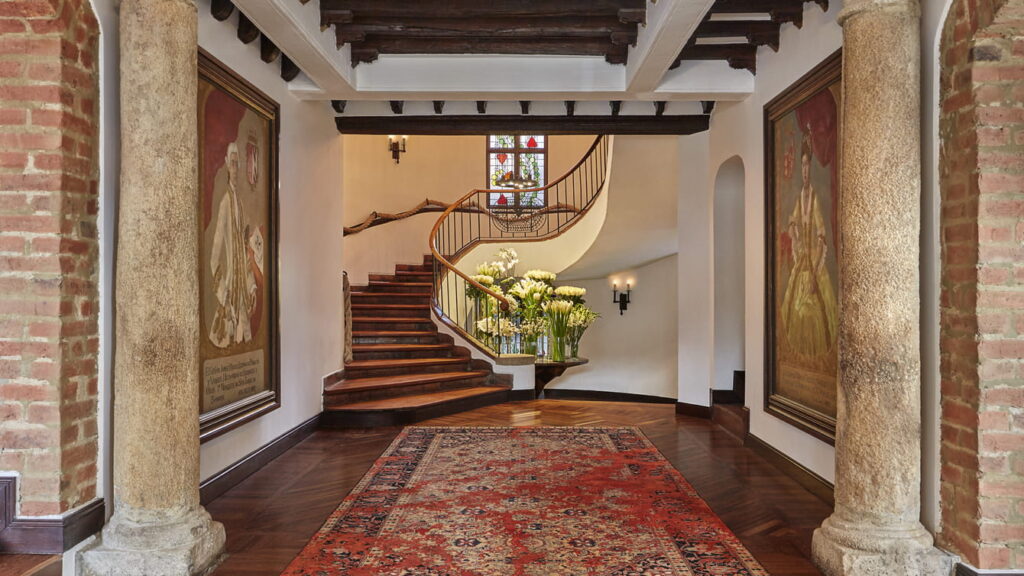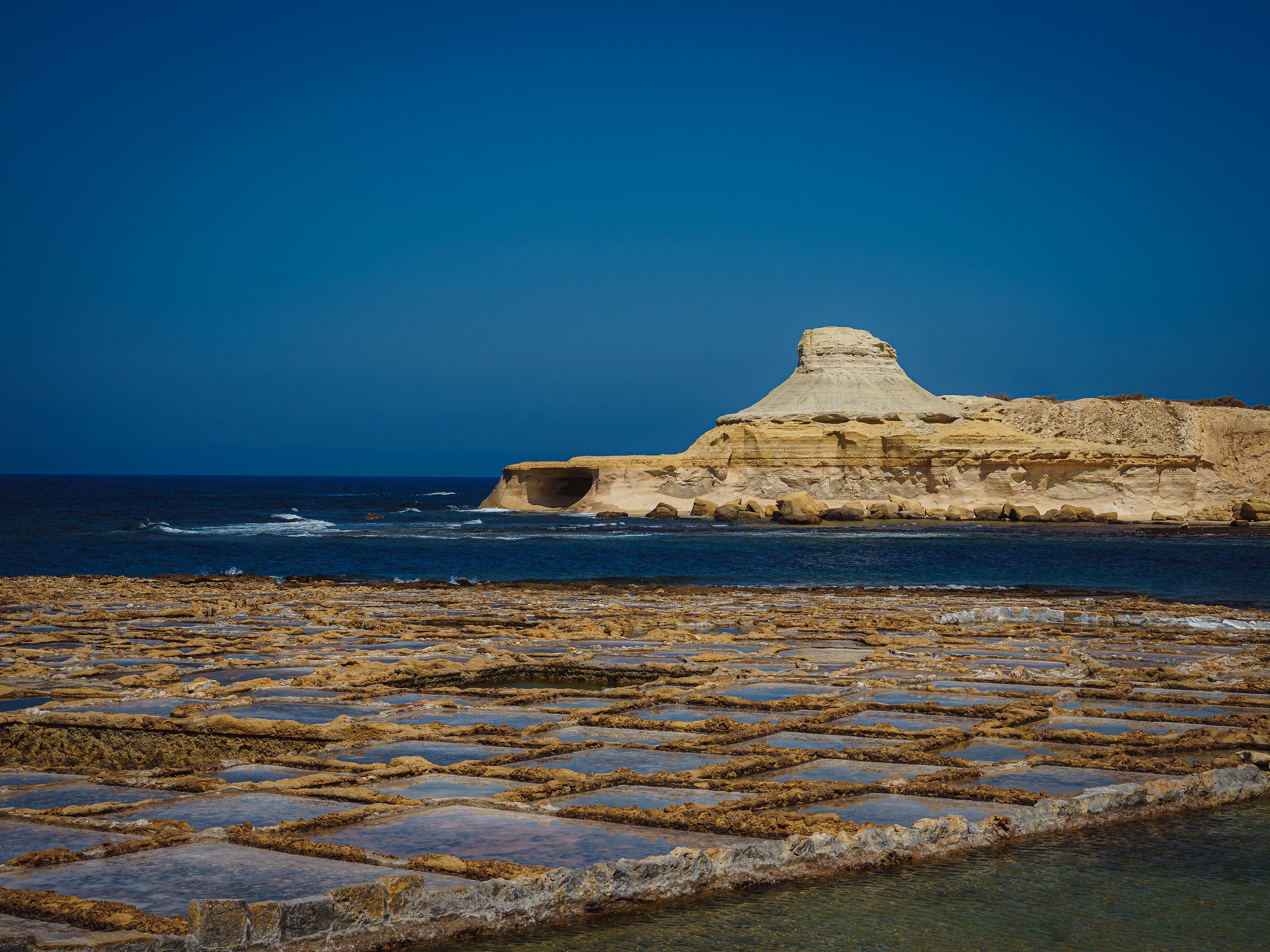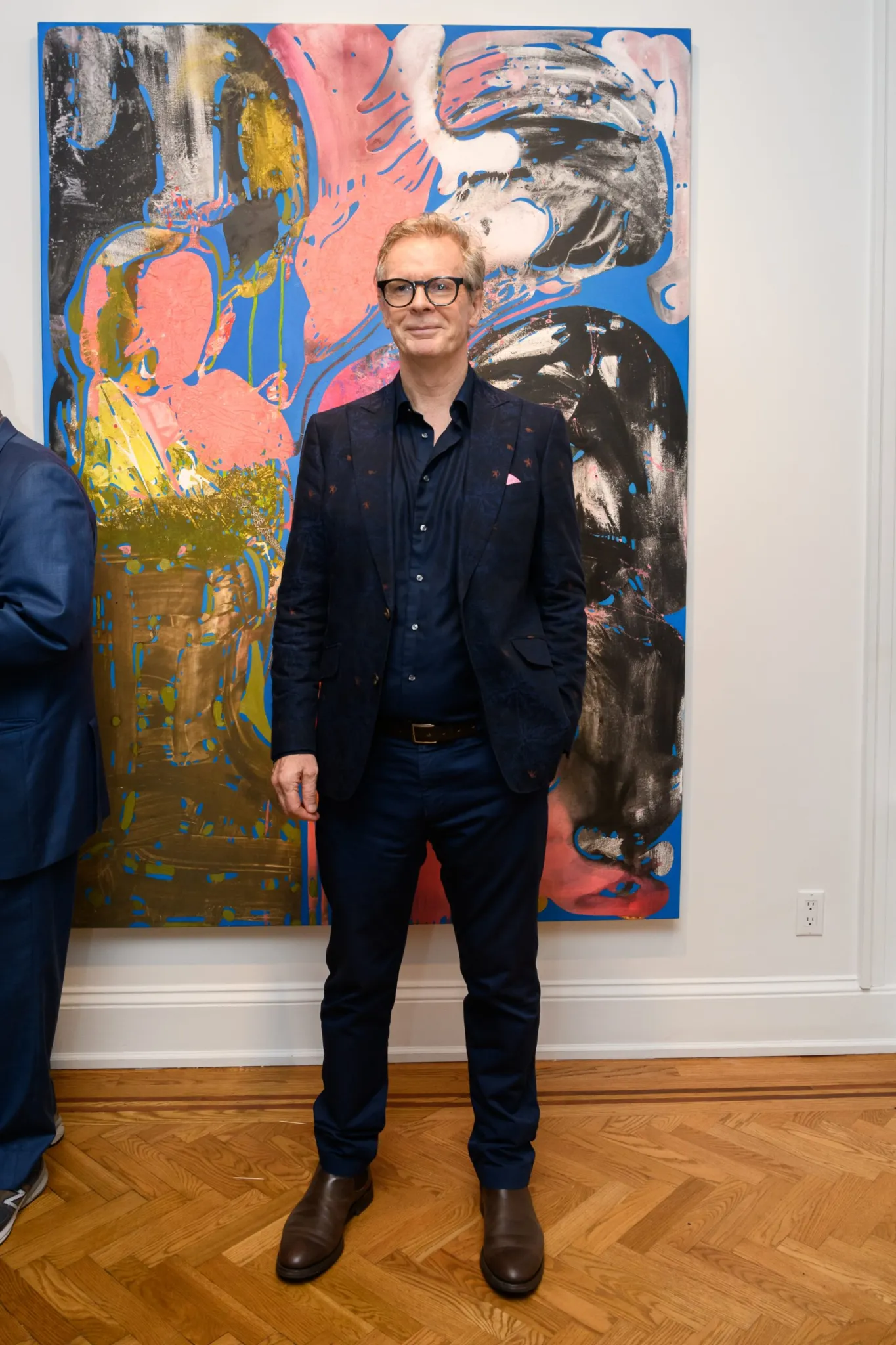“Step into the heart of Colombia’s cultural renaissance as we invite you to immerse yourself in the vibrant tapestry of Bogota’s top hotels. From colonial charm to contemporary luxury, discover how these accommodations serve as portals to an unforgettable journey through Colombian culture.”
I. Introduction
The dynamic city of Colombia Bogota, is a shining example of South America’s cultural diversity and depth. This expansive city, tucked away in the Andes highlands, is brimming with life and offers guests a wide range of experiences that honor the nation’s rich history. Bogota is a bustling metropolis where modernity and tradition coexist harmoniously. Its historic plazas are brimming with activity, and its streets are painted in vibrant murals.
Bogota’s best hotels, which are immersive entrances to Colombian culture rather than merely accommodations, are the center of the city’s cultural tapestry. These accommodations give visitors a once-in-a-lifetime chance to fully immerse themselves in Colombian culture, offering a glimpse into its customs, history, food, and art.
It is impossible to exaggerate the value of immersing oneself in Colombian culture via lodging in a world where travel experiences are becoming increasingly commercialized. Staying at Bogota’s best hotels goes beyond simple sightseeing and enables visitors to engage with the city’s cultural narrative actively. Guests are encouraged to thoroughly immerse themselves in the spirit of Colombian identity, whether through language and history programs, artful cuisine prepared with locally sourced products, or sophisticated wall art.
In this post, we will examine the various ways that Bogota’s best hotels facilitate cross-cultural dialogue and learning. We’ll explore the fascinating experiences that await visitors who decide to stay in the thriving Colombian capital as part of their cultural adventure, from gastronomy and design to art, architecture, and community involvement.
II. Cultural Experiences at Bogota’s Top Hotels
1. Design and Architecture
- Description of architectural styles and cultural influences in top hotels
- Four Seasons Hotel Casa Medina Bogota:
- Architectural Style: Hotel Casa Legado is a colonial-era structure with neoclassical characteristics situated in the famous La Candelaria district. Its facade has arched doors, ornamental moldings, and symmetrical proportions, typifying neoclassical architecture.
- Cultural Influences: The hotel’s interiors are decorated with traditional Colombian textiles, antique furniture, and artwork from the colonial era, which evokes memories of Bogota’s colonial history. In addition, guests can participate in cultural activities like cooking classes and live music performances, providing a greater understanding of Colombian culture.
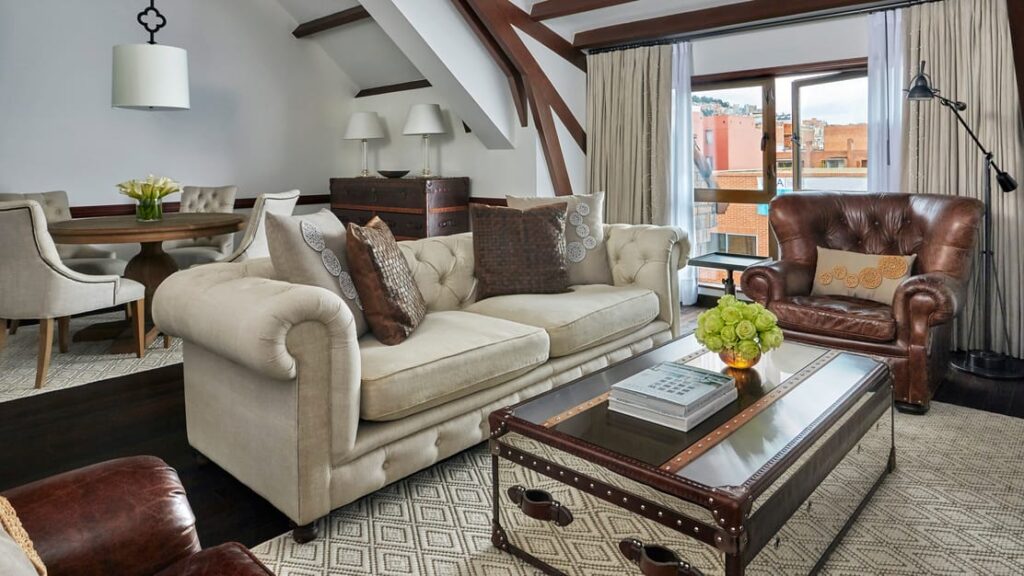
Booking: Four Seasons Hotel Casa Medina Bogota
- Hotel Casa Legado:
- Architectural Style: Hotel Casa Legado is housed in a colonial-era structure with neoclassical characteristics. It is situated in the famous La Candelaria district. Neoclassical architecture is typified by its facade’s arched doors, ornamental moldings, and symmetrical proportions.
- Cultural Influences: The hotel’s interiors are decorated with traditional Colombian textiles, antique furniture, and artwork from the colonial era, which evokes memories of Bogota’s colonial history. In addition, guests can participate in cultural activities like cooking classes and live music performances, providing a greater understanding of Colombian culture.

Booking: Hotel Casa Legado
- The Click Clack Hotel:
- Architectural Style: With its sleek, geometric features, floor-to-ceiling windows, and modern design, the Click Clack Hotel is a standout example of contemporary architecture. Bold colors and avant-garde architectural details adorn its facade, which captures the essence of Bogota’s contemporary metropolitan environment.
- Cultural Influences: The hotel honors Colombian culture with its colorful décor and artwork despite its contemporary style. In addition to participating in cultural activities and seeing the hotel’s changing exhibitions of local artists, guests may enjoy modern-day Colombian cuisine at the restaurant.
Booking: The Click Clack Hotel
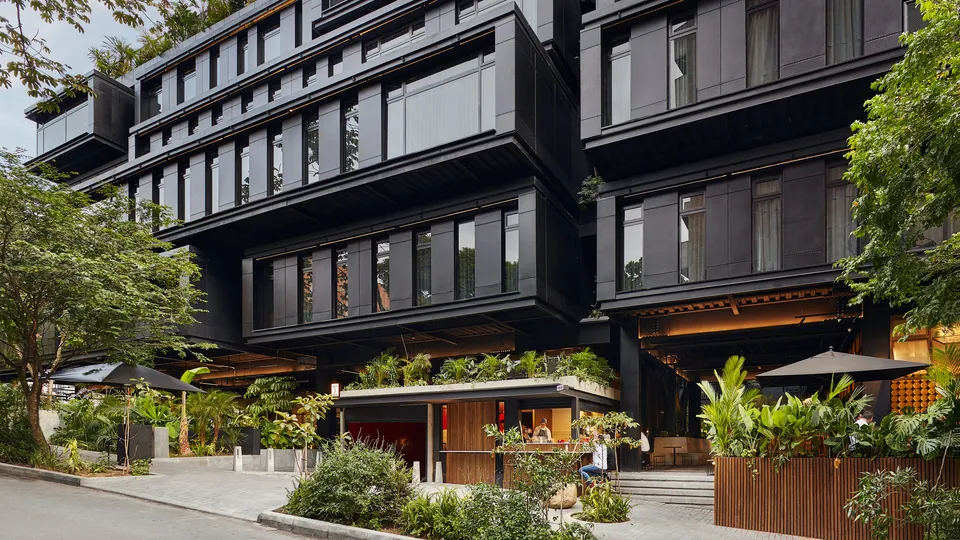
- JW Marriott Hotel Bogota:
- Architectural Style: The JW Marriott Hotel in Bogota’s financial sector features a contemporary architectural design emphasizing elegance and sophistication. Its modern design features, glass facade, and clean lines all help to make it a city icon.
- Cultural Influences: The hotel’s interior design subtly embraces Colombian culture, even if it tends towards modernism. With locally produced materials used in furniture and artwork with indigenous inspiration, the JW Marriott gives visitors a taste of true Colombian culture amid its modern surroundings.
Booking: JW Marriott Hotel Bogota
- Hotel de la Opera:
- Architectural Style: The Hotel de la Opera radiates opulence and old-world elegance. It is housed inside a magnificent colonial edifice with a view of the Teatro Colon. Its front has wrought iron railings adorning the balconies, arched windows typical of colonial architecture, and elaborate details.
- Cultural Influences: The hotel’s interior features artwork from the colonial era, antique furniture, and elaborate chandeliers that take visitors to the colonial splendor of Bogota. Cultural events that honor Colombia’s rich artistic legacy include opera performances and food excursions, giving visitors an authentic experience.
Booking: Hotel de la Opera
These best hotels in Bogota each feature a distinctive fusion of architectural designs and cultural elements, giving visitors an enthralling look into the city’s history, present, and future.
- Examples of unique design elements inspired by Colombian culture
- Handwoven Textiles:
- Handwoven textiles influenced by traditional Colombian handicrafts are a common feature in hotel design. Visitors may find vibrant blankets, pillows, and rugs created with methods handed down through the decades by indigenous groups, including the Wayuu, Emberá, and Kuna.
- Botanical Prints and Patterns:
- Colombia’s landscape and fauna frequently influence hotel design motifs. These design elements recall the nation’s vast biodiversity and lush environments, from elaborate patterns reminiscent of tropical vegetation to wallpaper and upholstery adorned with botanical prints.
- Mural Artwork:
- Many hotels in Bogota include murals as a significant feature, acting as focal points that highlight Colombian artwork and cultural heritage. These massive art pieces bring a lively and dynamic element to hotel interiors, frequently portraying scenes from Colombian history, mythology, and daily life.
- Coffee Culture:
- Hotels may use design cues influenced by Colombian coffee culture, as the nation is among the world’s top producers of coffee. Coffee-themed artwork, attractive coffee plant arrangements, or coffee-scented products honoring Colombia’s national beverage are a few examples.
- Traditional Crafts and Artifacts:
- Hotels may use traditional crafts and artifacts from Colombia as interior design elements. The nation’s artisanal solid traditions are exemplified by handcrafted pottery, wooden carvings, woven baskets, and intricately embroidered linens.
- Hammocks and Swing Chairs:
- Some hotels have hammocks or swing chairs in their common areas or guest rooms, drawing inspiration from the laid-back beach lifestyle of Colombia. These features create a warm and welcoming space for visitors to relax while recalling the carefree vibe of Colombia’s Caribbean coast.
- Botanical Gardens and Green Spaces:
- Certain hotels create tranquil havens amidst Bogota’s urban jungle by incorporating lush botanical gardens or interior green spaces into their architecture. These lush havens enhance the hotel’s surroundings while honoring Colombia’s place among the biodiverse nations of the globe.
- Colorful Ceramics and Pottery:
- Colombian ceramics and pottery are renowned for their elaborate designs and vivid colors. Hotels can use ornamental ceramics to give their interiors a splash of color and cultural flair by using them as wall hangings, tabletop accessories, or even valuable items like bowls and vases.
The distinctive atmosphere and sense of place visitors experience when staying at Bogota’s best hotels is enhanced by these unique design features influenced by Colombian culture. They provide stronger ties to the nation’s rich artistic traditions and legacy in addition to aesthetic appeal.
2. Gastronomy and Culinary Offerings
- Highlighting traditional Colombian dishes served at top hotels
- Bandeja Paisa: Widely regarded as the national cuisine of Colombia, this dish consists of a large platter with grilled meat, rice, beans, avocado, plantains, and arepas (corn cakes). A sophisticated version of this dish using premium ingredients and a sophisticated presentation may be offered by hotels.
- Lechona: A whole roasted pig packed with rice, peas, onions, and spices is the main ingredient in this traditional dish from the Tolima region. A gourmet version of lechona made with inventive side dishes or contemporary cooking methods could be available at certain hotels.
- Sancocho: Another well-liked Colombian soup, sancocho is a hearty dish stewed in a rich broth with meat (usually chicken or beef), potatoes, yuca (cassava), and other vegetables. Hotels might create their unique take on sancocho using local or seasonal products.
- Arepas are a mainstay of Colombian cooking. They can be baked, fried, or grilled and are typically served with a variety of fillings or toppings. Hotels may offer a variety of gourmet arepas with creative flavor combinations or premium ingredients.
- Cazuela de Mariscos: Popular in Colombia’s coastal areas, cazuela de mariscos is a seafood stew made with a variety of fresh seafood, including prawns, fish, and shellfish, simmered in a flavorful broth made with tomatoes, vegetables, and herbs. A classier take on cazuela de mariscos that emphasizes the freshness and quality of seafood can be found at hotels.
- Supposed to Negra: A meal of slow-cooked beef from the Caribbean coast, supposed to negra, is marinated in a thick, dark sauce made with cola soda, spices, panela, or unrefined cane sugar. Hotels may have their take on supposed to negra, enhancing the flavors with fine beef cuts and gourmet side dishes.
- Bunuelos: A typical Colombian treat, these fried dough balls are eaten at special events and holidays. They can be had for breakfast or as a dessert at hotels. For a taste of Colombian cuisine, they go well with traditional hot chocolate or coffee.
Bogota’s best hotels showcase traditional Colombian meals on their menus, allowing visitors to enjoy the genuine flavors of Colombia’s rich culinary heritage in a sophisticated and elegant environment.
- Emphasis on locally sourced ingredients and regional flavors
The best hotels in Bogota take great delight in highlighting foods sourced locally and the many flavors of Colombia. This is how they apply this emphasis to the food they serve:
- Partnering with Local Producers: To obtain the best and freshest products, hotels work with nearby farmers, fishermen, and craftspeople. They highlight the best of Colombia and contribute to the sustainability of the food systems in the area by assisting local producers.
- Highlighting Regional Specialties: Colombia’s several regions have distinctive culinary customs and tastes. To appreciate this diversity, hotels provide menu items tailored to the tastes of various areas, such as the Pacific, Caribbean, and Andean highlands.
- Farm-to-Table Dining: Many hotels use a farm-to-table strategy, obtaining their ingredients straight from local markets and farmers. This lessens the carbon footprint connected with food transportation while guaranteeing that guests experience seasonal produce at its peak of freshness.
- Creative Interpretations: Using cutting-edge flavor combinations and contemporary cooking methods, the chefs at Bogota’s best hotels give classic Colombian meals their unique twist. They enhance the eating experience by adding surprising twists and presentations while remaining faithful to the core of each dish.
- Culinary Experiences: Hotels offer visitors the opportunity to fully immerse themselves in Colombian cuisine through culinary experiences. These could be cooking lessons where visitors learn how to make classic meals using ingredients that can be found locally or carefully prepared tasting menus that highlight the wide range of flavors found in the nation.
- Seasonal Menus: The availability of locally grown produce and ingredients is reflected in the design of top hotels’ menus, which frequently change with the seasons. This helps the local farming community and guarantees visitors can always savor the freshest flavors.
- Supporting Sustainable Practices: Hotels place a high priority on sustainability in their culinary operations, in addition to locally sourced ingredients. This could entail employing eco-friendly packaging, reducing trash, and supporting campaigns encouraging ethical fishing and agricultural methods.
Bogota’s best hotels offer visitors a gastronomic voyage across Colombia’s varied landscapes and cultural legacy by emphasizing locally produced foods and regional flavors, all while supporting local communities and ecological practices.
3. Art and Entertainment
Art and Entertainment: Celebrating Colombia’s Cultural Tapestry
Top hotels in Bogota are lively centers of artistic expression and cultural immersion, providing visitors with a diverse range of art galleries, live music venues, and cultural events, all inside their opulent settings. These places do more than just house visitors; they also give local artists a stage to perform and interact with the rich cultural legacy of Colombia. Let’s examine how hotels arrange these events and contribute to Bogota’s thriving artistic community:
Exhibition of Art Galleries:
One of Bogota’s best hotels’ distinguishing features is their commitment to presenting a wide range of art collections that capture the artistic vitality of the nation. Hotel galleries provide visitors with a carefully chosen window into Colombia’s rich cultural diversity, showcasing everything from modern paintings and sculptures to traditional crafts and indigenous artifacts. These galleries frequently switch up their displays, showcasing up-and-coming artists and encouraging conversation about identity and the arts.
Live Musical Acts and Cultural Events:
Colombia’s hotels capitalize on live music being the nation’s lifeblood by presenting concerts that honor its rich musical past. The hotel’s vibrant atmosphere permeates as guests enjoy everything from jazz, salsa, and techno sounds to traditional Colombian folk music. Dance showcases and theatrical plays are examples of cultural performances that enhance the guest experience by providing an insight into Colombia’s rich cultural heritage.
Encouragement of Regional Artists and Cultural Projects:
The best hotels in Bogota are important supporters of regional artists and cultural projects, acting as both patrons of the arts and community organizers. Hotels sponsor exhibitions, create site-specific artworks, and incorporate art into their interior design in partnership with local artists. They also support the development of Bogota’s arts sector and give artists a platform to exhibit their work in front of a worldwide audience.
Hotels also regularly participate in cultural initiatives and organizations supporting artistic growth and cross-cultural exchange. This might be giving workshops and artist residencies, collaborating with nearby museums and galleries, or sponsoring events. Hotels enhance the visitor experience and promote a closer bond between tourists and the community by supporting Bogota’s cultural life.
To sum up, Bogota’s best hotels are vibrant cultural hubs that honor Colombia’s rich artistic legacy and innovative energy, not merely somewhere to stay. Hotels encourage local artists and cultural initiatives while providing visitors an immersive Colombian cultural experience through art galleries, live music, and artistic performances. Visitors are encouraged to interact with Bogota’s vibrant cultural tapestry, whether dancing to live music or appreciating a picture in the foyer.
4. Language and Heritage Programs: Preserving Colombian Culture through Education
Besides enjoying opulent lodging, visitors to Bogota’s best hotels are encouraged to take advantage of language courses and cultural immersion initiatives. These programs act as entry points into Colombia’s rich past, providing visitors with a more profound comprehension of the nation’s language, customs, and national identity. Let’s examine the many services offered by these hotels as well as the significance of using education to protect and promote Colombian heritage:
Overview of Language Classes:
The best hotels in Bogota understand that language is a key to cultural immersion. They therefore provide a range of language courses based on the requirements and preferences of their visitors. Hotels offer a variety of language services to suit different needs. These services include basic Spanish classes for tourists who want to speak with locals, seminars on Colombian slang and idioms, and advanced language courses for professionals who wish to improve their language skills.
Furthermore, a few hotels provide comprehensive language programs that integrate classroom learning with practical experiences like guided city tours, cooking classes, and cultural outings. These courses help visitors gain practical language skills while encouraging a greater understanding of Colombian culture.
Cultural Workshops and Experiences:
Top hotels in Bogota provide many cultural programs and activities that highlight Colombia’s rich legacy, in addition to language classes. Visitors can engage in practical experiences like cooking lessons where they learn how to make authentic Colombian meals with locally acquired products. Additionally, they can participate in craft classes taught by regional artisans to learn how to make traditional crafts, including weaving, woodcarving, and ceramics.
In addition, hotels organize cultural events that showcase many facets of Colombian culture, such as dance, music, and folklore. Through interactive presentations and live performances, guests can learn about Afro-Colombian heritage, mestizo culture, and indigenous customs of Colombia.
Importance of Preserving Colombian Heritage through Education:
Education is essential in maintaining and spreading Colombian history for the benefit of future generations. Bogota’s best hotels support preserving Colombia’s linguistic diversity and cultural traditions by providing language instruction and cultural seminars. These programs enable visitors to connect with nearby communities, cultivate intercultural comprehension, and advance cultural interchange.
Moreover, language and heritage initiatives help local communities and promote responsible travel, which catalyzes sustainable tourism growth. Visitors who engage meaningfully with Colombian culture serve as ambassadors for heritage protection and preservation, guaranteeing the long-term viability of Colombia’s rich cultural history.
To sum up, Bogota’s best hotels provide visitors with more than simply a place to stay—they also present chances for lifetime learning and cultural immersion. Hotels allow visitors to delve deeper into Colombia’s rich artistic legacy and strengthen their relationships through language instruction, cultural programs, and immersive experiences. Hotels, as custodians of Colombian legacy, are essential in promoting and conserving the country’s cultural identity via teaching.
III. Impact on Tourism and Community: Bogota’s Cultural Renaissance
Bogota’s best hotels are not just bastions of comfort and luxury but also hubs for community growth and cultural tourism. These lodging establishments are essential in determining Bogota’s appeal as a thriving cultural destination since they provide tourists with immersive cultural experiences and encourage meaningful interactions with local people. Let’s examine the various ways in which these initiatives affect tourism and the neighborhood:
1. Boosting Cultural Tourism:
Travelers looking for genuine experiences are drawn to Bogota’s rich cultural heritage, and the best hotels in the city act as entry points to this cultural rebirth. Bogota’s hotels contribute to the city’s allure by providing a wealth of cultural experiences, such as art galleries, live music events, and cooking classes, to travelers keen to experience the nation’s rich history.
Furthermore, these cultural encounters offer opportunities for deeper engagement with Colombian culture, going beyond just sightseeing. Travelers can enhance their travel experiences and develop a stronger bond with the location by learning about Colombia’s history, customs, and way of life. For example, they can experience local cuisine, learn traditional dance movements, or discover indigenous art forms.
Economically speaking, cultural tourism substantially contributes to Bogota’s tourism sector by bringing in money for lodging facilities, dining establishments, tour companies, and neighborhood businesses. Bogota’s best hotels stimulate demand for cultural experiences and job possibilities in the tourism industry by drawing in tourists interested in local culture. This promotes economic growth and prosperity in the area.
.
2. Fostering Cultural Exchange:
To foster meaningful connections that advance respect and understanding of different cultures, hotels act as links between visitors and the local population. Hotel guests can interact with local artists, musicians, and business owners and learn about their customs and cultural legacy through guided tours, cultural seminars, and community participation programs.
These exchanges enhance the visitor experience and foster appreciation and respect for one another among visitors and residents. Hotels contribute to dismantling barriers and preconceptions through cultural interchange, cultivating an inclusive and tolerant spirit that cuts beyond national boundaries and promotes global citizenship.
3. Supporting Local Communities:
The best hotels in Bogota are committed to assisting regional businesses, artists, and cultural organizations through various programs and alliances. Sourcing goods and services locally, hotels help artisans and small companies while boosting the local economy.
In addition, hotels participate in environmentally friendly tourism initiatives and community service projects that help the local populace. Examples include setting up volunteer opportunities, funding health and education programs, and implementing eco-friendly practices like energy and waste conservation and waste reduction.
By making these efforts, hotels show their dedication to social responsibility and responsible tourism, ensuring that tourism benefits visitors and the communities they visit. Hotels are essential to creating a more just and inclusive future for Bogota and its citizens because they empower local communities and support sustainable development.
To sum up, Bogota’s best hotels significantly promote cultural tourism, encourage cross-cultural interaction, and help out the community. These hotels contribute to Bogota’s cultural vibrancy and economic prosperity by providing immersive cultural experiences, fostering interactions between guests and locals, and advocating for sustainable tourism practices. They also promote cross-cultural understanding and appreciation on an international level.
IV. Challenges and Future Trends: Navigating Sustainability and Innovation in Bogota’s Hospitality Sector
Hotels in Bogota confront a wide range of opportunities and problems as the city’s hospitality industry develops, including how to embrace technological advancements, ensure sustainability, and adjust to shifting customer needs. Let’s examine these topics in greater detail:
1. Sustainability and Responsible Tourism:
Maintaining Bogota’s natural resources and cultural legacy is essential to the industry’s long-term viability. Hotels have to balance serving visitors’ needs with safeguarding the environment and nearby communities. By introducing energy-efficient procedures, cutting waste, and supporting local suppliers, hotels can reduce their environmental impact and boost the local economy.
Also, hotels can participate in responsible tourism programs that prioritize community empowerment and cultural preservation. This could entail sponsoring projects that empower underprivileged communities, providing educational programs on sustainable living, and collaborating with neighborhood organizations to encourage heritage protection. Hotels may support Bogota’s long-term success and preserve its natural and cultural heritage for future generations by embracing a holistic approach to sustainability.
2. Technological Innovations:
Technology is increasingly enhancing hotel guests’ cultural experiences. Technological advances offer great potential to engage visitors and present Colombia’s rich legacy in fresh and creative ways, such as immersive virtual tours and interactive digital storytelling. Hotels may develop immersive experiences that take customers to famous monuments, historical locations, and cultural events by utilizing augmented reality (AR), virtual reality (VR), and internet platforms.
Developments in data analytics, machine learning, and artificial intelligence (AI) may significantly impact cultural tourism’s direction. Hotels may better anticipate their guests’ wants and customize their experiences by utilizing chatbots with AI and personalized recommendation systems. Furthermore, social media and digital platforms give hotels practical marketing and storytelling tools to reach a worldwide audience and highlight Bogota’s cultural charms.
3. Adapting to Changing Demands:
Hotels must remain flexible and adaptable to the ever-changing needs of travelers and cultural trends in an ever-changing hospitality landscape. This calls for a dedication to ongoing innovation and adaptability in addition to a thorough comprehension of the changing requirements and expectations of the guests. By adopting new cultural trends, such as the increasing need for health programs, sustainable travel experiences, and genuine cultural immersion, hotels can remain relevant.
Furthermore, cultivating a creative and collaborative culture can encourage innovation and constructive change within the hospitality sector. Hotels can work with regional designers, artists, and businesspeople to produce distinctive visitor experiences that highlight Bogota’s artistic prowess and cultural uniqueness. By being aware of cultural developments and embracing innovation, hotels can maintain competitiveness and provide unforgettable experiences that appeal to today’s sophisticated travelers.
In summary, navigating sustainability and innovation presents opportunities and problems for Bogota’s hospitality industry. Hotels can lead Bogota’s changing cultural tourism scene by emphasizing ethical travel, adopting new technology, and remaining aware of shifting cultural expectations. By working together, being creative, and being committed to sustainability, hotels in Bogota can contribute to a more promising future for the hospitality sector while safeguarding the city’s artistic legacy for future generations.
V. Conclusion: Embracing Bogota’s Cultural Renaissance
Unquestionably, Bogota has transformed into a thriving cultural hub, drawing visitors worldwide with its diverse arts scene, rich legacy, and thriving hospitality industry. As we approach the end of our investigation into Bogota’s cultural renaissance, it is evident that the best hotels in the city significantly influence how visitors interact with the city and develop a stronger bond with Colombian culture.
As we’ve traveled, we’ve seen that Bogota’s best hotels offer more than just abundant lodging—they serve as entry points into the country’s rich cultural heritage. These hotels, which range from sleek modern buildings to historic mansions, serve as centers of artistic expression and cultural immersion while simultaneously reflecting Bogota’s architectural diversity.
Hotels give visitors a holistic experience celebrating Colombia’s rich legacy and promoting intercultural understanding through art galleries, live music, language classes, and cultural seminars. Hotels enable visitors to interact meaningfully and significantly with Bogota’s cultural fabric by presenting local artists, sponsoring community projects, and advocating for eco-friendly travel practices.
As tourists, we have the chance to properly appreciate Bogota’s cultural revival. Staying at Bogota’s best hotels allows us to actively participate in Colombia’s cultural story and experience unmatched luxury and comfort. Let’s respond to this call to action by booking accommodations at these outstanding places and delving deeply into Colombian culture.
Let’s embrace the spirit of Bogota and create enduring relationships with its people and legacy, whether through appreciating indigenous artwork, tasting traditional cuisine, or mastering the rhythms of salsa. By working together, we can see directly the enchantment of Colombia’s cultural renaissance and support Bogota’s ongoing ascent to prominence as a global cultural hub.
Let’s set out on this cultural adventure with open minds and hearts, prepared to connect, discover, and learn. Bogota awaits us, inviting us to explore its artistic treasures and have lifelong experiences.
FAQs:
What is the cultural capital of Colombia?
- The cultural capital of Colombia is often considered to be the city of Bogotá. As the capital and largest city of Colombia, Bogotá is home to numerous cultural institutions, museums, theaters, art galleries, and festivals that celebrate Colombia’s rich cultural heritage and diversity.
What is Colombian culture known for?
- Colombian culture is known for its vibrant and diverse mix of indigenous, African, and European influences. It is characterized by its music, dance, literature, art, cuisine, and festivals. Colombian culture is also known for its warmth and hospitality, with Colombians often being described as friendly and welcoming people.
What is Bogotá Colombia known for?
- Bogotá, Colombia, is known for being a vibrant cultural and economic hub in South America. It is renowned for its rich history, colonial architecture, bustling street life, and cosmopolitan atmosphere. Bogotá is also known for its thriving arts scene, innovative gastronomy, and lively nightlife.
What are the two capitals of Colombia?
- The two capitals of Colombia are:
- Bogotá: The official capital and largest city of Colombia, located in the Andean region of the country.
- Cartagena: The historic capital of the Bolívar Department and a major tourist destination, known for its well-preserved colonial architecture and rich history on the Caribbean coast of Colombia.

